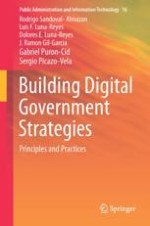2017 | OriginalPaper | Buchkapitel
6. Managing Information Technology Development Projects
verfasst von : Rodrigo Sandoval-Almazán, Luis F. Luna-Reyes, Dolores E. Luna-Reyes, J. Ramon Gil-Garcia, Gabriel Puron-Cid, Sergio Picazo-Vela
Erschienen in: Building Digital Government Strategies
Aktivieren Sie unsere intelligente Suche, um passende Fachinhalte oder Patente zu finden.
Wählen Sie Textabschnitte aus um mit Künstlicher Intelligenz passenden Patente zu finden. powered by
Markieren Sie Textabschnitte, um KI-gestützt weitere passende Inhalte zu finden. powered by
